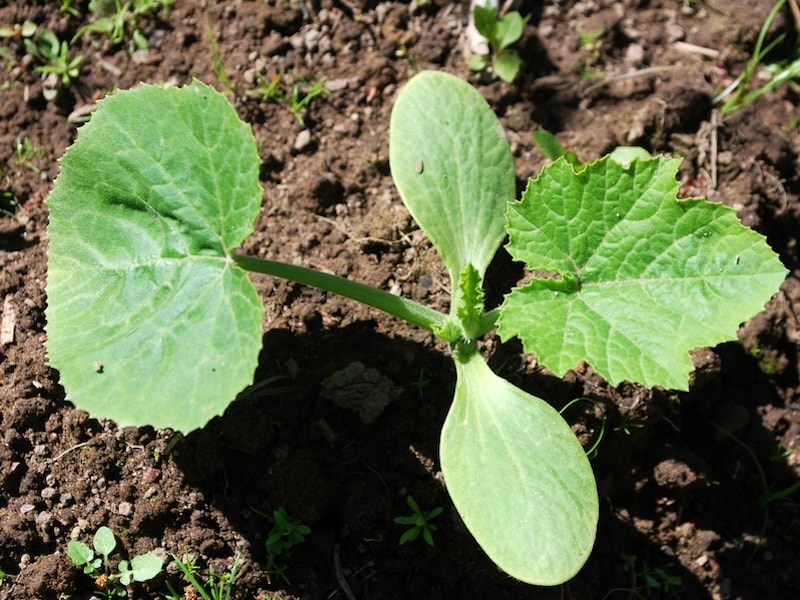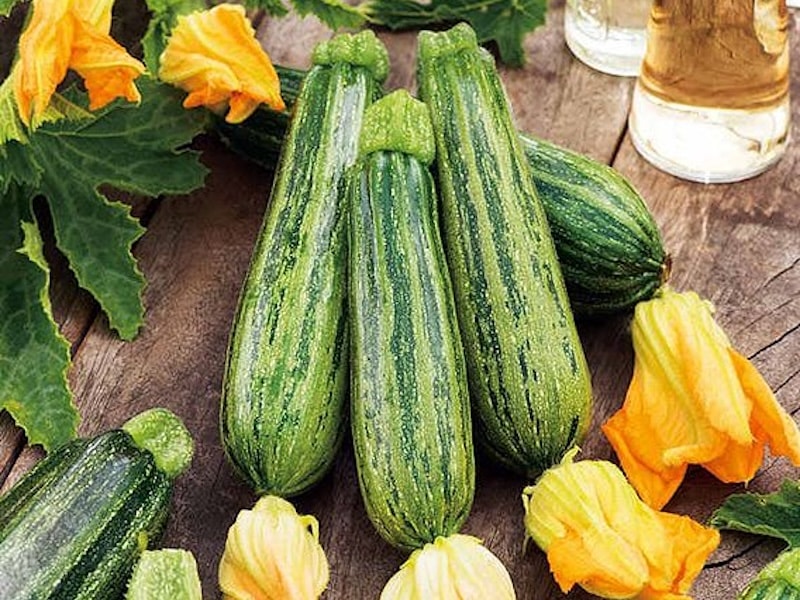Expensive to buy but a cinch to grow, courgettes are one of the most rewarding crops. Whether sowing courgette seed or buying courgette plants, there’s a wide range of sizes and habits suited to every growing space – from compact varieties for patio containers to trailing types for large plots. With an array of funky colours and shapes to choose from, they also make a fun growing project for children.
This fast-growing vegetable easily produces impressive harvests and offers an abundance of tasty recipes for the whole family. Here’s everything you need to know about growing your own courgettes.
How to choose the best courgettes

Image: Courgette ‘Defender’ from Suttons
For standard green courgettes with reliable yields and good disease resistance, Courgette ‘Defender’ has long been the most popular choice. This RHS award-winning variety crops early and heavily, giving an extended picking season. Plants have excellent resistance to the dreaded Cucumber Mosaic Virus and are completely spineless, making harvesting easy.
If space is limited, Courgette ‘Sure Thing’ is perfect for growing in patio containers or raised beds. This compact variety will fruit early even in cooler summers and does not require insects for pollination so it is ideal for urban areas and small greenhouses.
Yellow courgettes are less watery than green types, offering a crispier texture and subtly different flavour. The golden fruits of Courgette ‘Butterstick’ are slightly sweet and delicious sliced thinly and added to salads.
If you fancy a courgette of every stripe, opt for the dashing Courgette ‘Courcourzelle’ – a compact variety suited to patio containers that bears fruits striped in shades of yellow and green.
Not all courgettes are straight – for a fun change from standard types, plump for the round, firm-fleshed fruits of Courgette ‘Summer Holidays’ or the tennis-ball-sized Courgette ‘Ball Mix’.
When to sow courgette seeds

Image: Courgette ‘Butterstick’ F1 hybrid seeds from Suttons
Don’t sow your courgettes too early! Courgettes are tender plants that cannot withstand frost and are sensitive to cold temperatures. Sow indoors about a month before the last frost is expected. In most areas the last frost is between the end of April and the middle of May. Don’t fret that this is too late – once plants are established, they will romp away.
Seeds can be sown directly outside from late May to early June, although this is a riskier method and not recommended.
How to sow courgette seeds

Image: Shutterstock
Sowing courgette seed indoors
Sow courgette seed into small pots about 7-9cm filled with multipurpose compost. Forget old advice about sowing them on their edge – courgettes germinate equally well whichever way you sow them. Make a hole in each pot with your finger or a dibber about 1-2cm deep. Drop one seed in each hole and cover it over with compost. Water your pots so that they are evenly moist but not saturated. To retain humidity – cover your pots with clear plastic/glass or place them in a propagator or plastic bags.
To account for losses and to choose the best and strongest plants, sow more seeds than the number of plants you need – but don’t go overboard! Each courgette plant can produce around 20 fruits so 2 or 3 plants are plenty for most households.
Courgette seed requires soil temperatures of 13-15C to germinate so a sunny windowsill will suffice, although a heated propagator on a low setting will speed up germination. Check the pots every day and keep them moist. Courgette seeds germinate in about 7-10 days. Once you spot the smallest sign of growth peeping through the compost, whip the pots out from their propagator or bags.
Sowing courgette seed outdoors
Although courgettes can be sown directly outdoors, failure rates will be high. Erratic germination, colder temperatures plus the fact that mice, slugs and snails enjoy courgette seeds and seedlings, means that most growers opt for indoor sowing. If you are determined to go ahead, sow three seeds per station and pray. If you are lucky to have any seedlings that survive, you can thin them out to about 90cm apart! Plants sown outdoors will crop later in the summer than those grown outdoors.
Buying ready-grown courgette plants
If you are short on space or time – cheat! No one will know! Our ready-grown courgette plants are available for purchase in season.
How to care for courgette seedlings

Image: Shutterstock
Keep your seedlings moist but beware of overwatering as this can encourage stem rot. Grow them on in bright, even light. Courgettes are ready to plant out once they have formed two leaves and a third is starting to develop. Before planting out, gradually expose plants to cooler temperatures for 10 to 14 days to harden them off. If you don’t have a cold frame, this can be done by placing them outside during the day and then bringing them back under cover each evening.
Where do courgettes grow best

Image: Courgette seeds ‘F1 Midnight’ from Suttons
Choose a sheltered position in full sun in fertile, moisture-retentive soil with good drainage. Dig in plenty of well-rotted manure or compost before planting to improve the condition of the soil.
Growing courgettes in the veg plot
If you have the space, courgettes can be planted in traditional rows. Allow them plenty of room. Plant in rows 90cm (36in) apart or use them to fill gaps wherever available.
Growing courgettes vertically
Courgettes tend to sprawl across the ground, but with a bit of encouragement, they can be trained to grow skywards! Vertical growing has multiple advantages. It maximises the use of space, keeps fruits off the ground away from pests, and enhances exposure to the sun and air. It will also make harvesting a lot easier, especially as courgette plants have prickly hairs that can irritate the skin. Construct A-frames or teepees using bamboo canes stuck firmly into the ground. Regularly tie in the plants with soft string as they grow.
Aside from patio types, most courgette varieties can be trained to grow upwards. But if you fancy something a bit wacky, have a go with Squash ‘Tromboncino’, which has long stems and tendrils. Although officially a squash, ‘Tromboncino’ is picked when young and green and tastes like a superior courgette. Read our guide to growing tromboncino for more information.
Growing courgettes in containers
If space is limited, courgettes can be grown in containers. Choose compact, patio varieties such as Courgette ‘Midnight’ or ‘Sure Thing’ and plant them in large, plastic containers at least 50cm wide, filling them with good quality, multipurpose compost. Alternatively, you can use grow bags. Plants grown in containers and grow bags will run out of water and nutrients more quickly, so regular watering and fertilising are essential.
How to plant courgettes

Image: Courgette ‘Sure Thing’ (Patio) F1 from Suttons
Be ruthless and select only the strongest, healthiest plants for planting. Plant out young plants after all risk of frost has passed – in most areas this will be from the end of May. If you are growing under protection, such as cloches, planting can be done earlier.
Plants can be planted through groundcover fabric or surrounded with organic mulching material such as well rotted compost or Strulch. This will retain moisture and heat, control competing weeds and reduce the chances of fruit rot. When applying organic mulches, ensure that you keep the material away from plant stems to prevent rotting.
Water plants well before planting. When planting, avoid burying the neck of the plant below soil level as this can cause stem rot. Planting with the neck slightly above ground level is preferable.
Protect young plants from slugs and snails by thinly sprinkling organic slug pellets that contain ferric phosphate around them, or encircling individual plants with ‘Slug gone’ wool pellets.
Water well after planting and continue to monitor watering until the plants are established. Watch out for signs of water stress, such as wilting leaves. Avoid watering in full sunshine as young plants are easily scorched.
How to care for courgettes

Image: Shutterstock
Watering
Courgettes are thirsty plants and require regular watering, especially during hot, dry weather. Plants subject to water stress are more likely to succumb to pests and diseases. Water the soil and avoid splashing the leaves as this can promote fungal diseases. Plants growing in containers will dry out more easily so you may wish to consider a drip irrigation system.
Feeding
Once plants start to flower, feed them with a high potash fertiliser such as tomato feed every 10-14 days.
Pollination
Most courgette varieties require pollination by insects, although there are a few parthenocarpic varieties such as Courgette ‘Sure Thing’ that are capable of pollinating without them.
In cold seasons or early in the year, fruits may fail to form and hand pollination is recommended. Courgettes have separate male and female flowers. Female flowers can be identified by the small, baby fruit behind the flower. Male flowers have no fruit behind them and more of them tend to be produced early in the season, with female flowers catching up as the summer progresses. To hand pollinate, simply pick a fully open male flower, remove the petals and push it into each female flower to transfer the pollen.
Cleaning plants
Keep plants healthy by cutting off any mildewed leaves or small, unfertilised fruits that are starting to wither as these can attract moulds.
When to harvest courgettes

Image: Courgette ‘Courcourzelle’ seeds from Suttons/©Floramedia
Courgettes are extremely fast growers – producing their first fruits about 8 weeks from sowing. Don’t worry if the first fruits are slightly misshapen – this is normal. Harvest courgettes when they are young and tender and only about 10-15cm long. Pick every day to encourage continual cropping. Once large fruits are allowed to develop, the plant’s vigour and fruiting potential slows dramatically.
Common courgette problems
Slugs and snails
Slugs and snails may munch a few mouthfuls out of your courgettes before you do and are also partial to the soft tissues of courgettes seedlings. Protect plants with organic deterrents as soon as you plant them out. Remove debris around the plants as this provides damp hiding places for hungry molluscs.
Powdery mildew
Powdery mildew causes a white powdery coating on the leaves. The foliage shrivels up and dies and plant vigour deteriorates. There is no remedy for this problem but practise good hygiene by removing dead leaves and other debris around the plant. Prevent water-stress by irrigating regularly whilst avoiding leaf-splash and mulch around plants to retain moisture. Ensure that plants are well spaced to allow good air flow between them. Modern F1 hybrids have better resistance to attack than older cultivars.
Cucumber Mosaic Virus
Cucumber Mosaic Virus or CMV is a virus transmitted largely by aphids that causes irregular mottling, yellowing and distortion of the leaves. Plants become stunted, loose vigour and fruiting is reduced. Affected plants should be removed and not composted.
There is no cure for CMV but choosing modern, resistant varieties such as Courgette ‘Defender’ will reduce the chances of attack. Many weeds, in particular Groundsel and Chickweed, harbour the virus, so try to keep the area as weed free as possible. Spray with a non-toxic pesticide-free control to minimise aphid attacks.
We hope you’ve found our courgette guide helpful. For more helpful tips from independent garden bloggers, Instagrammers and YouTubers, read our article: Best expert advice on growing courgettes.
Lead image: Courgette (Organic) Seeds – Black Beauty from Suttons
Last Updated on December 11, 2024 by Suttons Horticultural Team




